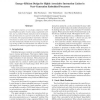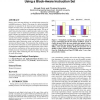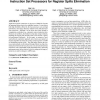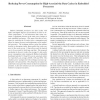23 search results - page 1 / 5 » Energy-Efficient Design for Highly Associative Instruction C... |
DATE
2004
IEEE
13 years 8 months ago
2004
IEEE
This paper proposes a low-energy solution for CAMbased highly associative I-caches using a segmented wordline and a predictor-based instruction fetch mechanism. Not all instructio...
CASES
2007
ACM
13 years 8 months ago
2007
ACM
Energy, power, and area efficiency are critical design concerns for embedded processors. Much of the energy of a typical embedded processor is consumed in the front-end since inst...
GLVLSI
2007
IEEE
13 years 8 months ago
2007
IEEE
Application-specific instruction set processor (ASIP) has become an important design choice for embedded systems. It can achieve both high flexibility offered by the base processo...
DATE
2003
IEEE
13 years 10 months ago
2003
IEEE
Modern embedded processors use data caches with higher and higher degrees of associativity in order to increase performance. A set–associative data cache consumes a significant...
ICCD
2004
IEEE
14 years 1 months ago
2004
IEEE
Many embedded processors use highly associative data caches implemented using a CAM-based tag search. When high-associativity is desirable, CAM designs can offer performance advan...




